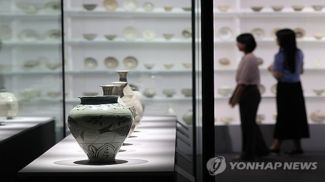ATHENS, 11 April (BelTA - Anadolu Agensy). - The Turkish city of Kutahya, known in ancient times as Cotyaeum, situated in the western part of the country along the Porsuk River, has long been famed for its pottery and ceramics, with production dating as far back as the 15th century.
In a tribute to the history of the city's pottery, the Benaki Museum of Islamic Art in Athens recently hosted an exhibit with magnificent pieces from the city that take viewers on a colorful journey into the past.
Adorning the exhibit, which ended last month, were pieces with bright motifs of cobalt blue, turquoise, yellow, red, and green giving a tiny taste of the handcrafts of the city.
Several historical events influenced but also interrupted the production of the pottery of Kutahya, including the Balkan wars, World War I, and the War of Turkish Independence (1919-1923), but its reputation as a distinguished center for pottery endured.
Dinos Kogias is an Athens lawyer by profession, but out of his passion for the pottery of Kutahya, for decades he has researched the history behind it.
Kogias became a researcher and curator of the “Souvenir of Kutahya” exhibit at the Benaki Museum. Along with other researchers, he founded a center called Diktio dedicated to the collection, research, and study of modern Greek, Ottoman, and Balkan ceramics.
“Even as a boy, I wanted to know the story, what was hiding behind every piece I saw,” he told Greek daily Kathimerini in an interview.
He started his collection of objects and archival material from Kutahya several years ago, spurred by the acquisition in 2002 of some ceramics from Kutahya with Greek inscriptions.
Telling Anadolu Agency that he knew of the existence of such vessels from references he saw elsewhere, Kogias explained: “But when I first held them in my hands, I realized that they are a special category of ceramics, important evidence of a historical and collective past that we have now forgotten or simply do not know.”
Inspired by the glazed motifs and through 129 original fascinating and colorful items shown in the exhibit, he gave his own personal account of the unknown and richly endowed pottery of Kutahya and its influences.
Decline of Iznik pottery and rise of Kutahya
Kutahya's pottery was very much influenced by the pottery of Iznik, in northwestern Turkiye, which enjoyed a worldwide reputation, and only after its decline did Kutahya rise in fame.
Kogias told Anadolu Agency how “after the decline of Iznik pottery in the 18th century, Kutahya's workshops flourished, producing a wide variety of pottery and tiles, often with obvious influences from Chinese and Japanese porcelain and pottery from Iran and Europe.”
In her book Kutahya Tiles and Ceramics, Hulya Bilgi, the director of Istanbul's Sadberk Hanım Museum, mentions several times how much the pottery made there was influenced from the Far East but also from Iznik.
However, Kutahya's pottery and ceramics were distinct from Iznik in the kinds of items produced in the 18th century, Bilgi said.
An attempt was made in the last quarter of the 19th century by craftsmen to revive the distant past by copying 16th century Iznik drawings, while the beginning of the 20th century saw a new boom period from mass orders for mosque monuments and other building coverings as part of the First National Architectural Movement, which incorporated elements of Ottoman and Seljuk architecture, Kogias says in his book Souvenir of Kutahya: Imprints of History on Kutahya Pottery (late 19th - early 20th century).
Busy workshops
According to Kogias, the most important workshops of this period were those of Hafiz Mehmed Emin Efendi, the Hadji Minassian brothers, and David Ohannessian, who often collaborated with each other to fulfill large orders.
At the western end of the city, Minas Avramidis was the most important representative.
However, World War I was at the city's doorstep, bringing with it a devastating impact on the city's economy, and many workshops were on the verge of bankruptcy due to understaffing, a lack of orders, and a general halt in trade and government procurement, Kogias said.
“After the Greek army occupied Kutahya on July 4, 1921, the Greeks got impressed by the city's porcelain, making it very popular, and with the reopening of the workshops, the first ceramics with Greek inscriptions appeared with the phrase ‘Souvenir of Kutahya',” he said.
Many of the items ended up in Greece, brought by Greek soldiers, which explains why much of the pottery bears commemorative inscriptions such as “Souvenir of Kutahya” along with the initials of the owners.
Yolanda Crowe, an independent scholar studying the local ceramics, said in a scholarly article that “archaeological finds in Kutahya and in a number of harbors such as London and Amsterdam as well as aboard shipwrecks have proved the popularity of Kutahya cups and saucers around the world in the 18th century, displaying a variety of designs.”
“There are over 70 pieces in the Victoria and Albert Museum in London, offering the possibility of studying the ceramic production of this relatively small Anatolian town on the Anatolian plateau, some hundred kilometers southeast of Bursa and Iznik,” said Crowe.
According to Kogias, most of the ceramic items were everyday items like trays, cups teapots, plates, vases and water bottles, but also bigger ones like tables.
Several mosques have also been decorated with tiles and ceramics from the city.
When the Greek occupation of Kutahya ended, most of the inhabitants of the city of Armenian or Greek origin started their exodus through Mudanya in Turkiye's Bursa province and Eastern Thrace, including the European side of Istanbul, into the Greek city of Thessaloniki.
Most of them settled in the capital Athens, Piraeus, Thessaloniki and other cities in Macedonia and Thrace. From 1923, pottery workshops and factories were established where Greek and Armenian craftsmen refugees from Kutahya worked, continuing the ceramic tradition of their homeland.
After the end of the war in Kutahya, young Turkish craftsmen and former students of the pottery of the Ottoman era of the city collaborated, reopened the workshops and gradually revived the pottery of their homeland in Turkiye's Republican era.
In 2016, the ceramic art of Kutahya was registered in UNESCO's list of the Intangible Cultural Heritage of Humanity, while in 2017, the city was included in the UNESCO Network of Creative Cities. Today, Kutahya remains the largest ceramic production center in Turkiye, with exports to many countries.













